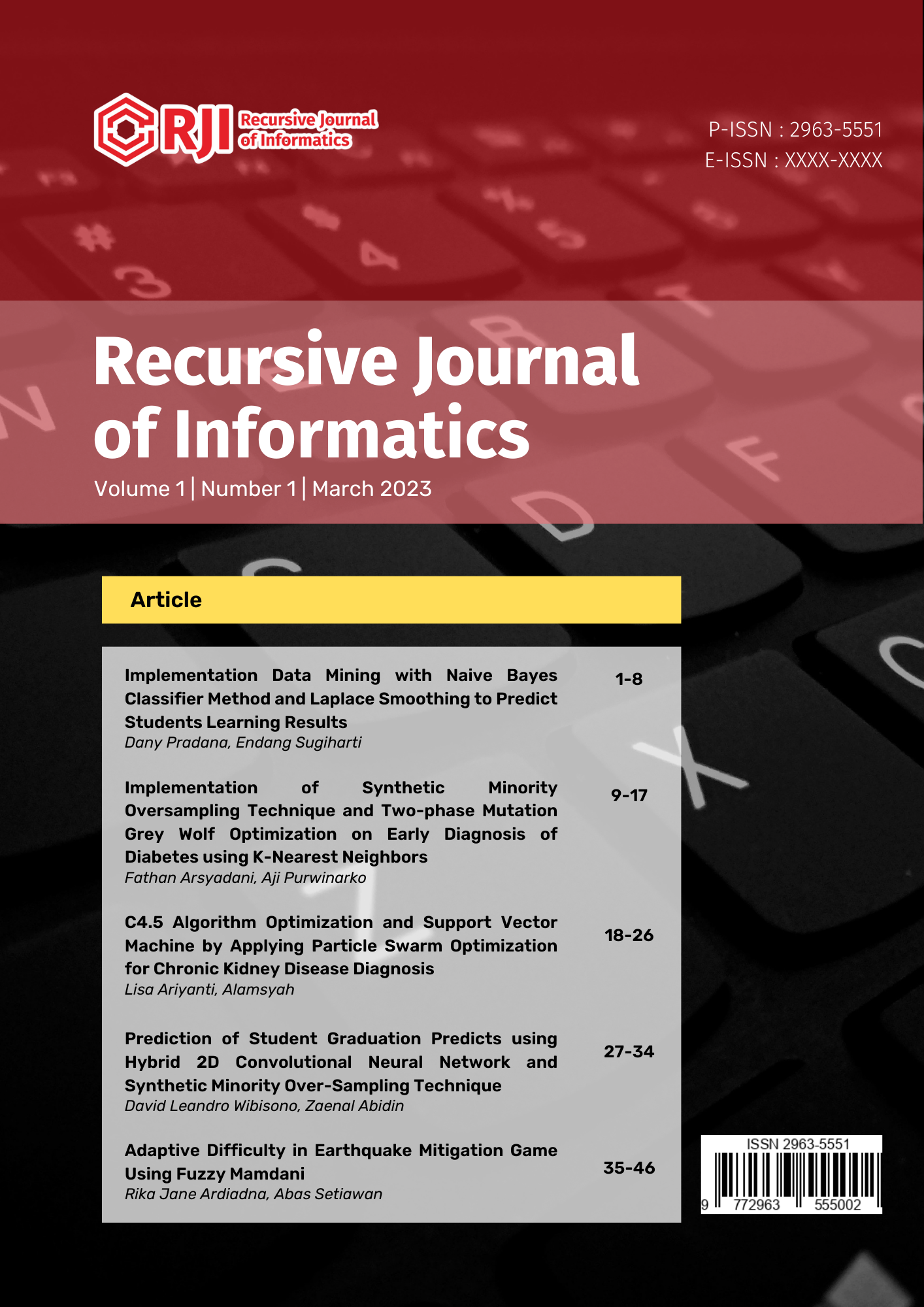Adaptive Difficulty in Earthquake Mitigation Game Using Fuzzy Mamdani
Abstract
Abstract. Earthquake disasters cause a lot of casualties. Therefore, needs to be education on earthquake disaster mitigation to minimize losses. In addition to counseling and teaching in schools, mitigation education can also be through games. Some education games for earthquake disaster mitigation have circulated quite a lot but have disadvantages, namely the difficulty level that hasn't been adaptive. A game requires an adaptive level of difficulty that can adjust between the ability and playing experience of the player with the level of difficulty so that players do not feel bored or frustrated.
Purpose: This study aims to provide earthquake disaster mitigation education and discuss making the level of difficulty in the game adaptive to suit the abilities and experience of the player.
Method: From the research carried out by applying the Mamdani Fuzzy Logic, the game's difficulty level for each player becomes more adaptive or different for each player according to the ability and experience of each player in the previous stage measured from 6 input parameters.
Result: The level of difficulty that is obtained becomes adaptive. It changes according to conditions or is adjusted based on the player's ability. It is from the playtesting experiment conducted on 20 players. The minimum difficulty level's score is five, and the difficulty level's score is 28.36.
Novelty: This paper's purpose is an educational game for earthquake mitigation with the feature of adaptive level based on fuzzy Mamdani.
References
[2] T. Yanuarto, S. Pinuji, A. C. Utomo, and I. T. Satrio, Buku Saku Tanggap Tangkas Tangguh Menghadapi Bencana. Pusat Data Informasi dan Humas BNPB, 2019.
[3] A. V. H. Simanjuntak and K. Ansari, "Seismicity clustering of sequence phenomena in the active tectonic system of backthrust Lombok preceding the sequence 2018 earthquakes," Arabian Journal of Geosciences, vol. 15, no. 23, p. 1730, Dec. 2022, doi: 10.1007/s12517-022-10973-y.
[4] H. Lei, X. Wang, H. Hou, L. Su, D. Yu, and H. Wang, "The earthquake in Jiuzhaigou County of Northern Sichuan, China on Aug. 8, 2017," Natural Hazards, vol. 90, no. 2, pp. 1021–1030, Jan. 2018, doi: 10.1007/s11069-017-3064-3.
[5] G. P. Hayes, G. M. Smoczyk, A. H. Villaseñor, K. P. Furlong, and H. M. Benz, "Seismicity of the Earth 1900–2018 Scientific Investigations Map 3446," 2020. Accessed: Feb. 04, 2023. [Online]. Available: http://pubs.er.usgs.gov/publication/sim3446
[6] Y. Zhang, J. F. Fung, K. J. Johnson, and S. Sattar, "Review of Seismic Risk Mitigation Policies in Earthquake-Prone Countries: Lessons for Earthquake Resilience in the United States," Journal of Earthquake Engineering, vol. 26, no. 12, pp. 6208–6235, Sep. 2022, doi: 10.1080/13632469.2021.1911889.
[7] S. Mohadjer et al., "Earthquake emergency education in Dushanbe, Tajikistan," Journal of Geoscience Education, vol. 58, no. 2, pp. 86–94, 2010, doi: 10.5408/1.3534854.
[8] N. A. Belinda, Linawati, and K. O. Saputra, "UI/UX Design of Educational Game for Earthquake Mitigation," in 2020 IEEE International Women in Engineering (WIE) Conference on Electrical and Computer Engineering (WIECON-ECE), Dec. 2020, pp. 70–73. doi: 10.1109/WIECON-ECE52138.2020.9398019.
[9] H. M. Ihsan, D. P. Putri, H. M. Insani, A. Redo, and A. S. Bratanegara, "Utilization of Fun Games as Earthquake Disaster Mitigation Efforts for Inclusive Children," Tunas Geografi, vol. 11, no. 2, p. 89, Dec. 2022, doi: 10.24114/tgeo.v11i2.39739.
[10] B. Nirmala, A. Agusniatih, and H. Annuar, "Development of snakes and ladders game (disaster response) as earthquake mitigation for children," Journal of Early Childhood Care and Education, vol. 3, no. 2, p. 97, Jan. 2021, doi: 10.26555/jecce.v3i2.3111.
[11] D. N. G. Botelho, "Treme-Treme 2.0-A serious game to teach children earthquake preparedness," Tecnico Lisboa, 2019.
[12] Z. Feng et al., "Towards a customizable immersive virtual reality serious game for earthquake emergency training," Advanced Engineering Informatics, vol. 46, p. 101134, Oct. 2020, doi: 10.1016/j.aei.2020.101134.
[13] J. Yu, A. R. Denham, and E. Searight, "A systematic review of augmented reality game-based Learning in STEM education," Educational technology research and development, vol. 70, no. 4, pp. 1169–1194, Aug. 2022, doi: 10.1007/s11423-022-10122-y.
[14] D. Vergara, Á. Antón‐Sancho, and P. Fernández‐Arias, "Player profiles for game‐based applications in engineering education," Computer Applications in Engineering Education, vol. 31, no. 1, pp. 154–175, Jan. 2023, doi: 10.1002/cae.22576.
[15] Y. Hu, T. Gallagher, P. Wouters, M. van der Schaaf, and L. Kester, "Game‐based learning has good chemistry with chemistry education: A three‐level meta‐analysis," J Res Sci Teach, vol. 59, no. 9, pp. 1499–1543, Nov. 2022, doi: 10.1002/tea.21765.
[16] M. Zohaib, "Dynamic Difficulty Adjustment (DDA) in Computer Games: A Review," Advances in Human-Computer Interaction, vol. 2018, pp. 1–12, Nov. 2018, doi: 10.1155/2018/5681652.
[17] X. Fang, J. Zhang, and S. S. Chan, "Development of an Instrument for Studying Flow in Computer Game Play," Int J Hum Comput Interact, vol. 29, no. 7, pp. 456–470, Jul. 2013, doi: 10.1080/10447318.2012.715991.
[18] N. P. H. Pratama, S. M. S. Nugroho, and E. M. Yuniarno, "Fuzzy controller based AI for dynamic difficulty adjustment for defense of the Ancient 2 (DotA2)," in 2016 International Seminar on Intelligent Technology and Its Applications (ISITIA), Jul. 2016, pp. 95–100. doi: 10.1109/ISITIA.2016.7828640.
[19] T. Killedar, G. Suriya, P. Sharma, M. Rathor, and A. Gupta, "Fuzzy Logic for Video Game Engagement Analysis using Facial Emotion Recognition," in 2021 8th International Conference on Signal Processing and Integrated Networks (SPIN), Aug. 2021, pp. 481–485. doi: 10.1109/SPIN52536.2021.9566124.
[20] A. Hubble, J. Moorin, and A. S. Khuman, "Artificial Intelligence in FPS Games: NPC Difficulty Effects on Gameplay," in Fuzzy Logic, Cham: Springer International Publishing, 2021, pp. 165–190. doi: 10.1007/978-3-030-66474-9_11.
[21] A. L. Sánchez and A. G. Lara, "A Serious Game prototype for strengthen Mathematical Logical Reasoning with implementation of Fuzzy Logic System," in Proceedings of the 7th Mexican Conference on Human-Computer Interaction, Oct. 2018, pp. 1–4. doi: 10.1145/3293578.3298780.









